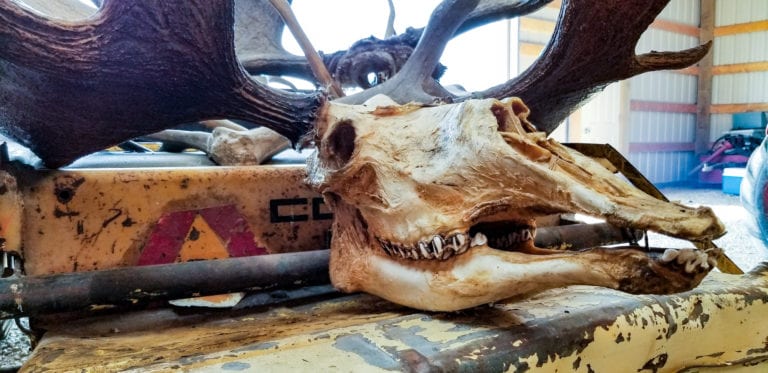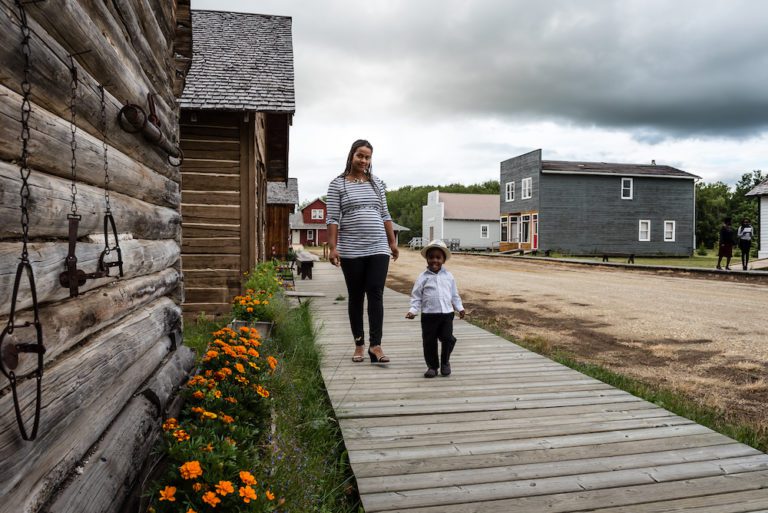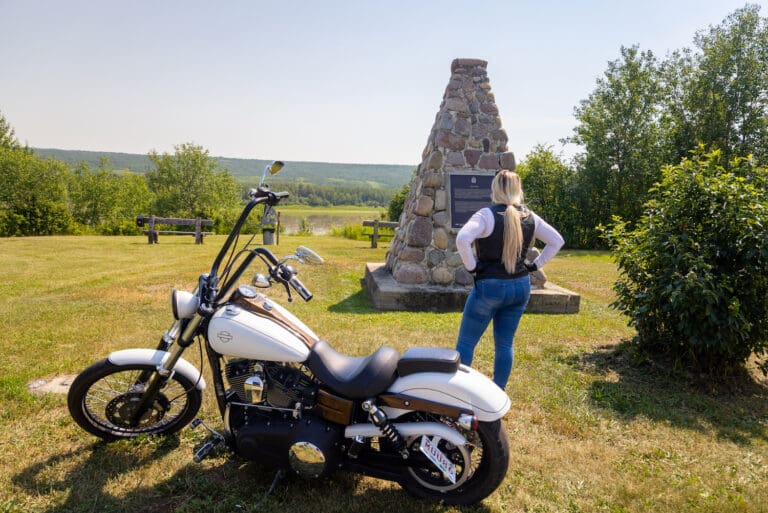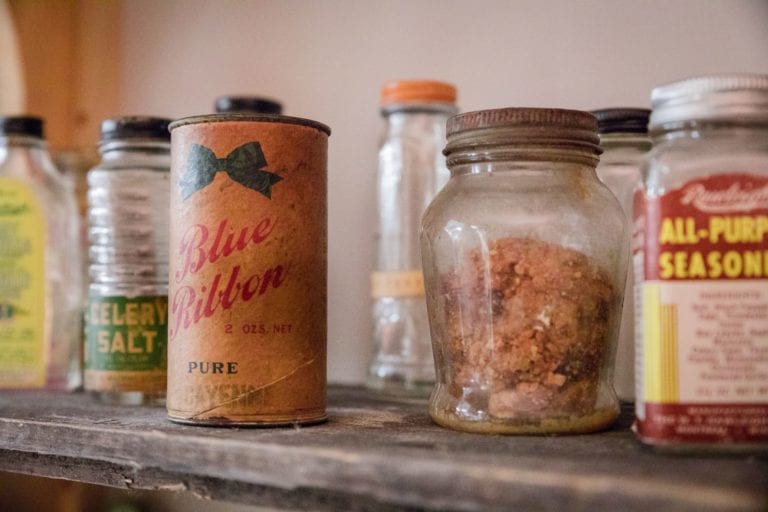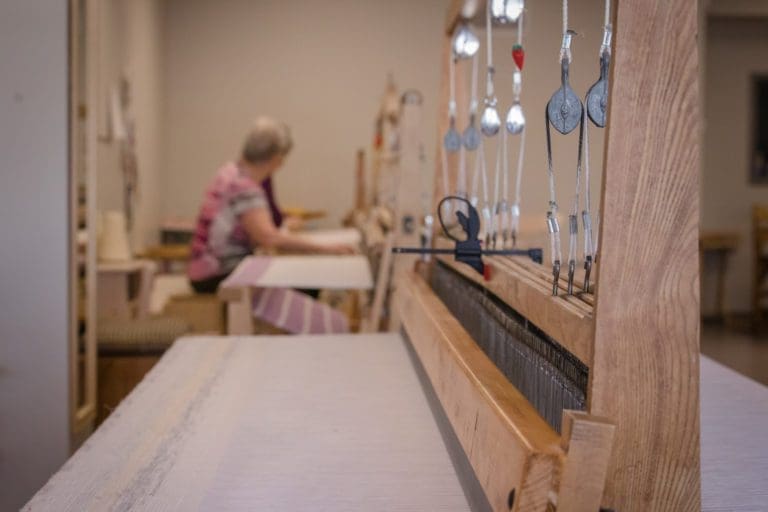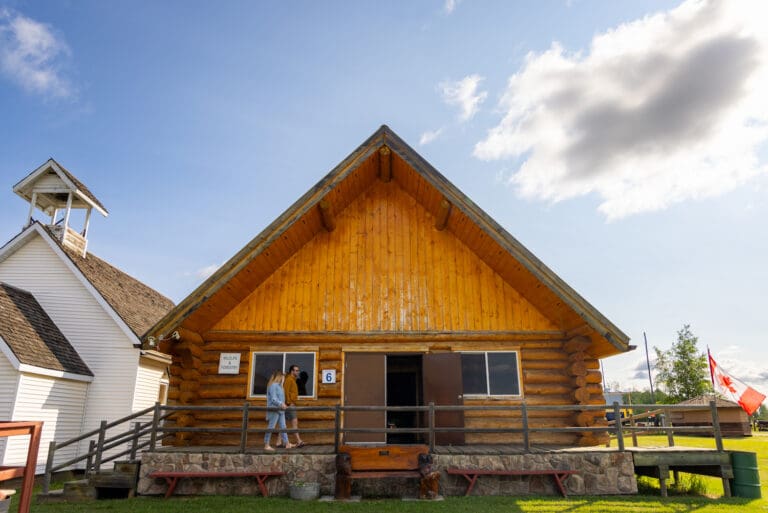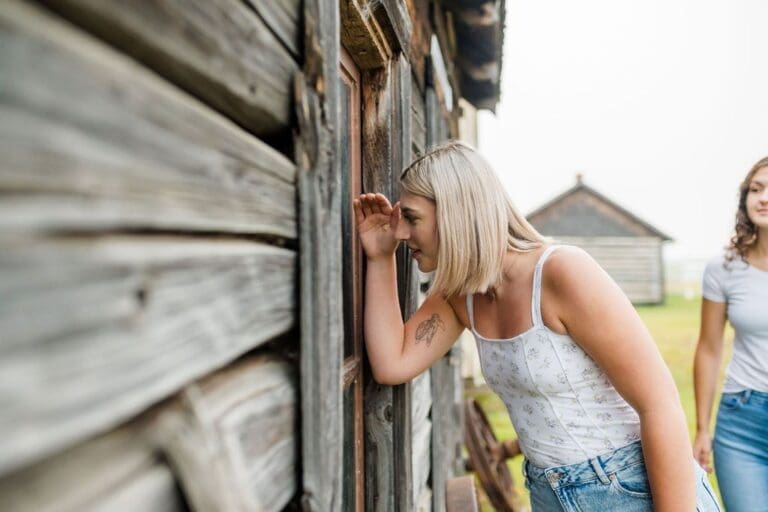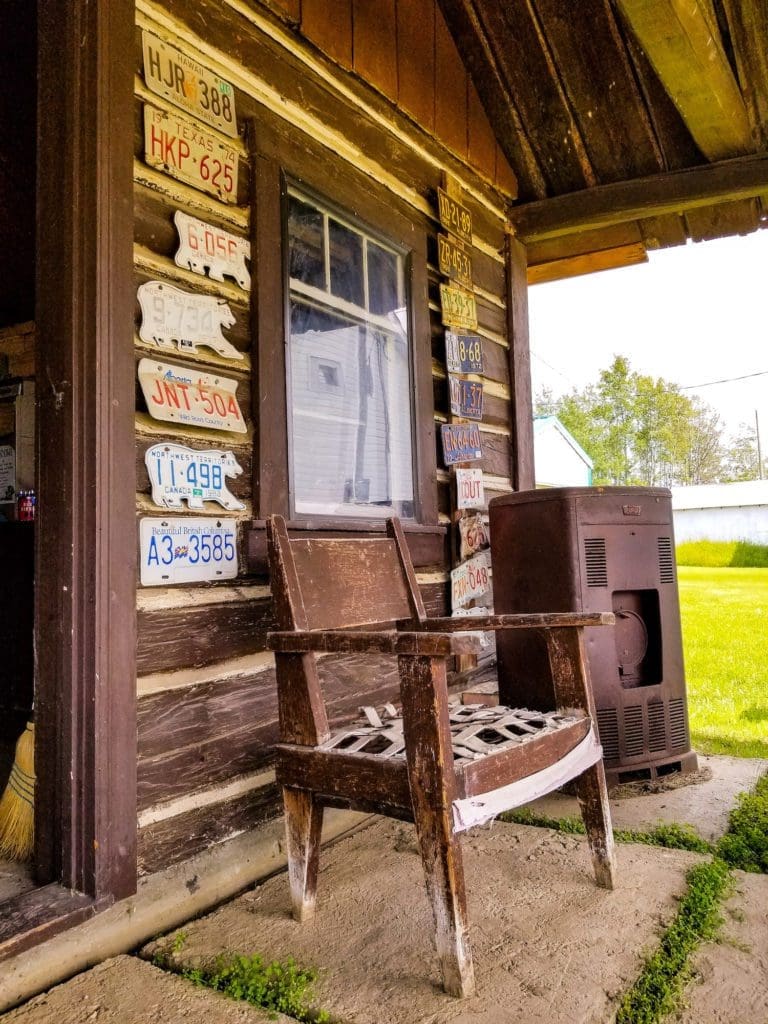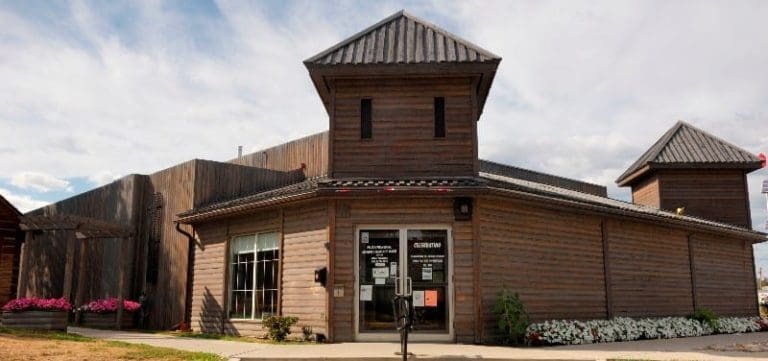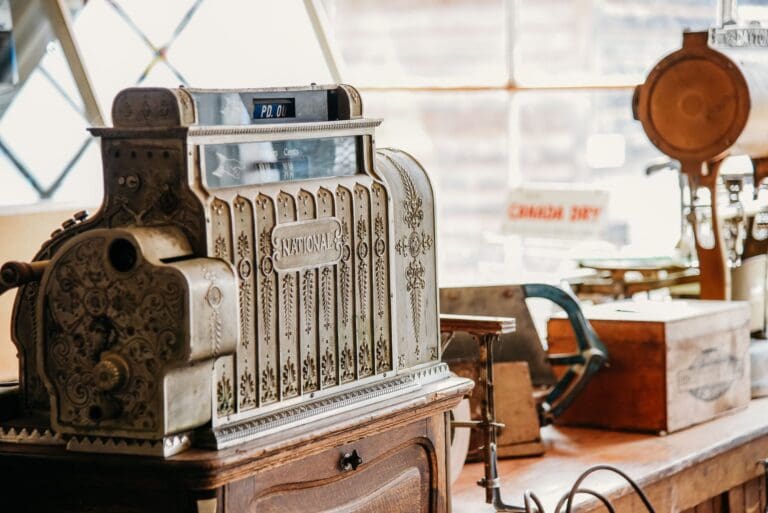No Records Found
Sorry, no records were found. Please adjust your search criteria and try again.
Google Map Not Loaded
Sorry, unable to load Google Maps API.
-
SavePlace Title: Battle River Pioneer MuseumPlace Description:
A mounted albino moose and a 1500 year old arrow head are just a couple of amazing things available to see at the Battle River Pioneer Museum. Visitors can easily imagine the town of Manning many years ago while touring the large main building, a cabin, post office, blacksmith shop and machine shed. An annual Heritage Day weekend antique tractor parade showcases the farm machinery used many years ago! Imagine the early pioneers at work while watching the Heritage Day demonstrations that may include wood working, rope making, and flour milling. The museum’s collection also includes a mounted moose, timber wolf, cougar, grizzly bear, albino porcupine and many other odd and unusual items.This museum located 1 km east of the Town of Manning on Secondary Highway 700 Hwy 691, Manning AB T0H 2M0.
Open May 15 – September 15, 10am to 6pm daily.
Museum – 780-836-2374
Off Season Museum – 780-836-0734
Address: 700 Hwy 691, Manning AB T0H 2M0
Town of Manning
Alberta
T0H 2M0
CanadaTelephone Number: 780 836-0734A mounted albino moose and a 1500 year old arrow head are just a couple of amazing things available to see at the Battle River Pioneer Museum. Visitors can easily imagine the town of Manning many years ago while touring the large main building, a cabin, post office, blacksmith shop and machine shed. An annual Heritage Day weekend antique tractor parade showcases the farm machinery used many years ago! Imagine the early pioneers at work while watching the Heritage Day demonstrations that may include wood working, rope making, and flour milling. The museum’s collection also includes a mounted moose, timber wolf, cougar, grizzly bear, albino porcupine and many other odd and unusual items.This museum located 1 km east of the Town of Manning on Secondary Highway 700 Hwy 691, Manning AB T0H 2M0.
Open May 15 – September 15, 10am to 6pm daily.
Museum – 780-836-2374
Off Season Museum – 780-836-0734
-
SavePlace Title: Lac Cardinal Pioneer Village MuseumPlace Description:
Experience the day to day life of a Peace Country pioneer at the Lac Cardinal Pioneer Village Museum. Stroll through this depiction of a typical 1920s to 1940s pioneer village and experience what life would have been like for these hardy pioneers. Immerse yourself in history as you tour four fully furnished houses, a school, a blacksmith shop and a general store! You can practically smell the bread baking in the bakery! The village also includes a fire hall, municipal office, carpenter shop, church, barn and library!
Pioneer Day celebrations are held annually on the second Saturday of August. This is a great way to enjoy the museum! Start your day with a pancake breakfast and then actually see the saw mill, threshing machine and blacksmith in operation! Witness butter being churned the old- fashioned way and then take a horse and wagon ride! Enjoy a lunch of beef on a bun and pie while listening to the musical entertainment on offer.
Directions – from Grimshaw – next to Queen Elizabeth Provincial Park, access from either Highway 2 or Secondary Highway 685.
Open May long weekend to September long weekend.
Hours of operation – Open Thursday to Monday (Closed Tuesday and Wednesday) 10:30am – 4:30pm.
Admission by donation.
Contact – 780-332-2030
Tags: Edu-vacationAddress: 10 km north-west of Grimshaw in northern Alberta, west of the junction of Highway 2 and Mackenzie Highway.
Grimshaw
Alberta
T0H 1W0
CanadaTelephone Number: (780) 332-2030Experience the day to day life of a Peace Country pioneer at the Lac Cardinal Pioneer Village Museum. Stroll through this depiction of a typical 1920s to 1940s pioneer village and experience what life would have been like for these hardy pioneers. Immerse yourself in history as you tour four fully furnished houses, a school, a blacksmith shop and a general store! You can practically smell the bread baking in the bakery! The village also includes a fire hall, municipal office, carpenter shop, church, barn and library!
Pioneer Day celebrations are held annually on the second Saturday of August. This is a great way to enjoy the museum! Start your day with a pancake breakfast and then actually see the saw mill, threshing machine and blacksmith in operation! Witness butter being churned the old- fashioned way and then take a horse and wagon ride! Enjoy a lunch of beef on a bun and pie while listening to the musical entertainment on offer.
Directions – from Grimshaw – next to Queen Elizabeth Provincial Park, access from either Highway 2 or Secondary Highway 685.
Open May long weekend to September long weekend.
Hours of operation – Open Thursday to Monday (Closed Tuesday and Wednesday) 10:30am – 4:30pm.
Admission by donation.
Contact – 780-332-2030
-
SavePlace Title: Fort Fork/Mackenzie CairnPlace Description:
Paddling furiously along the Peace River to beat freeze up, Alexander Mackenzie and his crew must have been very glad to reach the area where Fort Fork was to be built and where they were able to find shelter from the coming winter weather. Soon after his arrival Mackenzie observed “the river stopped” indicating freeze up had arrived! Mackenzie, a Scottish born explorer and fur trader was to spend the winter of 1792 – 93 at Fort Fork before continuing on his famed journey to the Pacific Ocean. Fort Fork was named for its close proximity to the convergence of the Smoky and Peace Rivers. The fort provided shelter for Mackenzie and several years later the explorer – geographer David Thompson. The fort was also the main North West Company post in the Peace Country until 1806 when its operations were moved to Fort Dunvegan. Stones from an original chimney in the fort have been preserved and fashioned into a fireplace for the public to view at the Peace River Museum, Archives and Mackenzie Centre.
Mackenzie Cairn, a National Historic site since 1929, was built to commemorate Fort Fork and marks the spot where visitors can look across the river to the approximate area of Fort Fork which has long since been erased by the ravages of time and river erosion. Mackenzie Cairn is found a short distance from the Town of Peace River, along the Shaftsbury Trail.
Tags: Circle TourAddress: On the Shaftesbury Trail
Peace River
Alberta
T8S 1X2
CanadaPaddling furiously along the Peace River to beat freeze up, Alexander Mackenzie and his crew must have been very glad to reach the area where Fort Fork was to be built and where they were able to find shelter from the coming winter weather. Soon after his arrival Mackenzie observed “the river stopped” indicating freeze up had arrived! Mackenzie, a Scottish born explorer and fur trader was to spend the winter of 1792 – 93 at Fort Fork before continuing on his famed journey to the Pacific Ocean. Fort Fork was named for its close proximity to the convergence of the Smoky and Peace Rivers. The fort provided shelter for Mackenzie and several years later the explorer – geographer David Thompson. The fort was also the main North West Company post in the Peace Country until 1806 when its operations were moved to Fort Dunvegan. Stones from an original chimney in the fort have been preserved and fashioned into a fireplace for the public to view at the Peace River Museum, Archives and Mackenzie Centre.
Mackenzie Cairn, a National Historic site since 1929, was built to commemorate Fort Fork and marks the spot where visitors can look across the river to the approximate area of Fort Fork which has long since been erased by the ravages of time and river erosion. Mackenzie Cairn is found a short distance from the Town of Peace River, along the Shaftsbury Trail.
-
SavePlace Title: All Saints Anglican ChurchPlace Description:
All Saints Anglican Church was declared a Municipal Historic Resource in 2009. The Church has been available to everyone for worship services, baptisms, weddings and funerals for the past 80 years. The church was an integral part of the early settlers’ community in an area that was geographically isolated by rivers on all sides and was a social focal point for three communities; Cherry Pont, Bear Canyon and Clayhurst.
Anglican missionaries began working in the area in the early 1930s, shortly after the first settlers arrived. Local volunteers constructed the building and the first service was held in the unfinished building on August 25, 1937.
The All Saints Anglican Church architecture incorporates gothic revival features such as the pointed arch windows and vaulted sanctuary that is separated from the nave by a railing. The original handmade box for the Chalice and Communion set is still used and the pews are original and hand hewn.
All Saints Anglican Church can be found approximately 80km West of Worsley in the Cherry Point area.
For information call – 780-685-3925
Address: All Saints Anglican Church can be found approximately 80km West of Worsley in the Cherry Point area.
Cherry Point
Clear Hills County
CanadaTelephone Number: 780-685-3925All Saints Anglican Church was declared a Municipal Historic Resource in 2009. The Church has been available to everyone for worship services, baptisms, weddings and funerals for the past 80 years. The church was an integral part of the early settlers’ community in an area that was geographically isolated by rivers on all sides and was a social focal point for three communities; Cherry Pont, Bear Canyon and Clayhurst.
Anglican missionaries began working in the area in the early 1930s, shortly after the first settlers arrived. Local volunteers constructed the building and the first service was held in the unfinished building on August 25, 1937.
The All Saints Anglican Church architecture incorporates gothic revival features such as the pointed arch windows and vaulted sanctuary that is separated from the nave by a railing. The original handmade box for the Chalice and Communion set is still used and the pews are original and hand hewn.
All Saints Anglican Church can be found approximately 80km West of Worsley in the Cherry Point area.
For information call – 780-685-3925
-
SavePlace Title: Historic Dunvegan Provincial ParkPlace Description:
Historic Dunvegan is a provincially and nationally designated historic resource. Experience history through 4 original, authentically restored and furnished buildings and the stories of Indigenous, fur trade, and mission life that our historic interpreters are waiting to share with you. Located alongside the Peace River with a breathtaking view of Alberta’s longest vehicle suspension bridge, there are activities for the whole family! A visitors’ centre located near the entrance offers information as well as guided tours of the historic buildings. The Visitor Centre and historic buildings are open from May 18 through Labour Day, 10am-5pm Wednesday through Sunday and holiday Mondays. Admission fees apply.
2024 Special Events
Dunvegan Tsattine/Beaver Storytelling – June 22, 1pm
Canada Day – July 1, Noon-5pm
Fresh Air Market – August 4, 11-5pm
Sunday Funday – May 19 and June 30, 10am-5pm
Picnic in the Park – July 14 and August 11, 11am-3pmLocated 26km south of Fairview on Highway 2. For more information please visit www.historicdunvegan.ca or find us on Facebook by searching @historicdunvegan!
Other nearby amenities include a day use area and campground operated by Alberta Parks. A playground, fire pits, cook shelters, and horseshoe pitches are all available. The Maples Day use area is just down the road, and offers a picnic shelter, fire pits, and a playground. You can also stroll down to the neighbouring Dunvegan Market Gardens for ice cream, food, shopping, and mini golf!
Category: Arts & Culture, Attractions, On the Peace River, Dark Sky Adventures, District of Fairview, Guided Adventure, Mighty Peace Essentials, Motorcycle Tours, Museums, Places To See, Sights & Experiences, and Things To DoAddress: Township Rd 801A
md of fairview
Alberta
T0H 0L0
CanadaTelephone Number: 780-835-7150Email: Historic.Dunvegan@gov.ab.caHistoric Dunvegan is a provincially and nationally designated historic resource. Experience history through 4 original, authentically restored and furnished buildings and the stories of Indigenous, fur trade, and mission life that our historic interpreters are waiting to share with you. Located alongside the Peace River with a breathtaking view of Alberta’s longest vehicle suspension bridge, there are activities for the whole family! A visitors’ centre located near the entrance offers information as well as guided tours of the historic buildings. The Visitor Centre and historic buildings are open from May 18 through Labour Day, 10am-5pm Wednesday through Sunday and holiday Mondays. Admission fees apply.
2024 Special Events
Dunvegan Tsattine/Beaver Storytelling – June 22, 1pm
Canada Day – July 1, Noon-5pm
Fresh Air Market – August 4, 11-5pm
Sunday Funday – May 19 and June 30, 10am-5pm
Picnic in the Park – July 14 and August 11, 11am-3pmLocated 26km south of Fairview on Highway 2. For more information please visit www.historicdunvegan.ca or find us on Facebook by searching @historicdunvegan!
Other nearby amenities include a day use area and campground operated by Alberta Parks. A playground, fire pits, cook shelters, and horseshoe pitches are all available. The Maples Day use area is just down the road, and offers a picnic shelter, fire pits, and a playground. You can also stroll down to the neighbouring Dunvegan Market Gardens for ice cream, food, shopping, and mini golf!
-
SavePlace Title: Brownvale North Peace Agricultural MuseumPlace Description:
Where in the Peace Country can you find a museum with a mechanical bull? The Brownvale North Peace Agricultural Museum! This fiberglass bull originally had Brian Mulroney riding him when the statue was built by the Alberta Government for the Alberta Pavilion showcased in Vancouver for Expo 86! The original cost was $30,000 but the Brownvale Museum was lucky enough to have it donated to them by George McKenzie who purchased it at auction for $4000. What better rider to portray than Brian Mulroney our Prime Minister in 1986, too bad he’s been bucked off since the statue was originally installed!
Continue on past the bull to explore the historical buildings on display – the Grey Eagle school and the Brownvale Post Office are available for visitors to explore. Slip back through the decades when you step inside the buildings which feature many artifacts from the past, such as some old tractors and a gramophone complete with records. The museum also includes a selection of other agricultural equipment and road building equipment dating back to horse powered days!
The museum is located on the coroner of Highway 2 and Highway 737. Free parking is available at this wheelchair accessible facility. The museum hours are 11am – 3pm every Sunday from the May long weekend through to the September long weekend. Donations are gratefully accepted. For more information call – 780-740-5048.
Category: MuseumsTags: Edu-vacationAddress: Brownvale
Municipal District of Peace
Alberta
CanadaTelephone Number: 780-597-3934Where in the Peace Country can you find a museum with a mechanical bull? The Brownvale North Peace Agricultural Museum! This fiberglass bull originally had Brian Mulroney riding him when the statue was built by the Alberta Government for the Alberta Pavilion showcased in Vancouver for Expo 86! The original cost was $30,000 but the Brownvale Museum was lucky enough to have it donated to them by George McKenzie who purchased it at auction for $4000. What better rider to portray than Brian Mulroney our Prime Minister in 1986, too bad he’s been bucked off since the statue was originally installed!
Continue on past the bull to explore the historical buildings on display – the Grey Eagle school and the Brownvale Post Office are available for visitors to explore. Slip back through the decades when you step inside the buildings which feature many artifacts from the past, such as some old tractors and a gramophone complete with records. The museum also includes a selection of other agricultural equipment and road building equipment dating back to horse powered days!
The museum is located on the coroner of Highway 2 and Highway 737. Free parking is available at this wheelchair accessible facility. The museum hours are 11am – 3pm every Sunday from the May long weekend through to the September long weekend. Donations are gratefully accepted. For more information call – 780-740-5048.
-
SavePlace Title: Nampa and District Museum and Tourist Information CenterPlace Description:
Explore the legendary Mighty Peace, from the fur trade to modern times, through the exhibits at our museum. Discover Nampa and Northern Sunrise County’s historic multicultural roots by following the steps of those who ventured to Canada’s northern-most homesteading area, across the Grouard Trail and onto the railways that took people from all over the world through muskeg to the Mighty Peace Country. Learn about local industries, about farming, about traditional ways as we guide you through the indoor and outdoor exhibits and buildings. With displays on two floors open year round and outdoor exhibits accessible from May to September, the Nampa and District Museum is more than worth a gander.
Major attractions include:
- The original water tank built by the Central Canada Railway to which Nampa owes its very own existence;
- Our old-time boardwalk of shops and businesses from the early to mid 1900’s;
- Our taxidermy exhibits, showing off local wildlife in the area
- The Rucka settlement house (circa 1937)
- Reno’s Ukrainian Catholic Church (circa 1946)
And so much more.
Hours of Operation
- June 1st to August 31st – 10 am to 5 pm / 7 days a week
- September 1st to May 31st – 10 am to 5 pm / Monday to Friday
- Admission: Seniors 65+ $3, Family $15, Adults $7, Students/children attending school $3, Children under 6 Free
Category: Agricultural, Arts & Culture, Circle Tour, Gift Shops & Other, Motorcycle Tours, Museums, Northern Sunrise County, Places To See, Shopping, Things To Do, and Village of NampaAddress: 9902 102 Avenue
Nampa
Alberta
T0H 2R0
CanadaTelephone Number: (780) 322-2777Email: nampamuseum@gmail.comExplore the legendary Mighty Peace, from the fur trade to modern times, through the exhibits at our museum. Discover Nampa and Northern Sunrise County’s historic multicultural roots by following the steps of those who ventured to Canada’s northern-most homesteading area, across the Grouard Trail and onto the railways that took people from all over the world through muskeg to the Mighty Peace Country. Learn about local industries, about farming, about traditional ways as we guide you through the indoor and outdoor exhibits and buildings. With displays on two floors open year round and outdoor exhibits accessible from May to September, the Nampa and District Museum is more than worth a gander.
Major attractions include:
- The original water tank built by the Central Canada Railway to which Nampa owes its very own existence;
- Our old-time boardwalk of shops and businesses from the early to mid 1900’s;
- Our taxidermy exhibits, showing off local wildlife in the area
- The Rucka settlement house (circa 1937)
- Reno’s Ukrainian Catholic Church (circa 1946)
And so much more.
Hours of Operation
- June 1st to August 31st – 10 am to 5 pm / 7 days a week
- September 1st to May 31st – 10 am to 5 pm / Monday to Friday
- Admission: Seniors 65+ $3, Family $15, Adults $7, Students/children attending school $3, Children under 6 Free
-
SavePlace Title: St. Isidore Museum & Cultural CentrePlace Description:
St. Isidore Museum & Cultural Centre – English
Situated in the quaint hamlet of St-Isidore, is a museum that depicts the storied heritage of the francophone community that left Quebec to establish itself in the Mighty Peace. In the museum, you’ll find costumes, pictures and artefacts that tell the story of hardships and victories. Also, theres a train car replica inside of the museum to help visualize the trek that the families had to make with their enormous families as well as with their livestock.
St. Isidore Museum & Cultural Centre – French
Situé dans le pittoresque hameau de St-Isidore, ce musée présente l’héritage historique de la communauté francophone qui a permis au gens du Québec de s’établir au sein de la région de Rivière-de-la-Paix. Dans le musée, vous trouverez des costumes, des images et des artefacts qui racontent l’histoire des épreuves et des victoires. De plus, il y a une réplique d’un wagon de train à l’intérieur du musée pour aider à visualiser le trek que les familles devaient faire avec leur famille et avec leur bétail. Nous accueillons tout le monde, même si vous ne parlez pas français.
Tisserandes De St. Isidore (St. Isidore Weavers)
Weaving is an ancient art!
At the Centre Culturel de St-Isidore the St. Isidore Weavers share their talents and perpetuates the traditional arts and crafts of their ancestors. Stop by and admire or take home a piece of their work.
Hours Of Operation:
- Monday – Thursday, 9:00am -4:30pm
- Fridays – Call (780)624-8481
Category: Agricultural, Arts & Culture, Attractions, Library, Museums, Places To See, Shopping, and Town of Saint IsidoreTags: Circle Tour Contest, Edu-vacation, Francophone Circle Tour, and Northern Sunrise County DestinationAddress: Bouchard Road
Saint Isidore
Alberta
T0H 3B0
CanadaTelephone Number: (780) 624-8481Email: explorestisidore@gmail.comSt. Isidore Museum & Cultural Centre – English
Situated in the quaint hamlet of St-Isidore, is a museum that depicts the storied heritage of the francophone community that left Quebec to establish itself in the Mighty Peace. In the museum, you’ll find costumes, pictures and artefacts that tell the story of hardships and victories. Also, theres a train car replica inside of the museum to help visualize the trek that the families had to make with their enormous families as well as with their livestock.
St. Isidore Museum & Cultural Centre – French
Situé dans le pittoresque hameau de St-Isidore, ce musée présente l’héritage historique de la communauté francophone qui a permis au gens du Québec de s’établir au sein de la région de Rivière-de-la-Paix. Dans le musée, vous trouverez des costumes, des images et des artefacts qui racontent l’histoire des épreuves et des victoires. De plus, il y a une réplique d’un wagon de train à l’intérieur du musée pour aider à visualiser le trek que les familles devaient faire avec leur famille et avec leur bétail. Nous accueillons tout le monde, même si vous ne parlez pas français.
Tisserandes De St. Isidore (St. Isidore Weavers)
Weaving is an ancient art!
At the Centre Culturel de St-Isidore the St. Isidore Weavers share their talents and perpetuates the traditional arts and crafts of their ancestors. Stop by and admire or take home a piece of their work.
Hours Of Operation:
- Monday – Thursday, 9:00am -4:30pm
- Fridays – Call (780)624-8481
-
SavePlace Title: End of Steel MuseumPlace Description:
END OF STEEL MUSEUM
Bringing the homesteading history of Hines Creek to life.
The End of Steel Museum opened to the public in 1985 and has been growing and evolving ever since. The museum celebrates the history of the Hines Creek area which is unique because it was the end of the railway line. The tracks were built only to the point that freight rates would have increased and no further. This entailed the moving of the village, from its original site on the creek from which it takes its name, to the present day location. Hines Creek became a transportation hub with the arrival of the first train in December of 1930 and at one point there were five grain elevators along the tracks.
The museum has three historic houses: the Pohaboff House (1928) which is a good example of the sort of small hand-hewn log house built by arriving immigrant settlers; the Carter House (1938) is an unusually large and somewhat grand home, especially as it was built during the Great Depression as Art Carter (of Carter Camp) owned a sawmill; the French “Half-House” (1948-1949) is exactly that, only half the two story home was ever constructed due to financial problems, the staircase is incredibly narrow. These three homes are furnished with time appropriate artifacts to give visitors the feeling that the owners’ might return at any moment.
Hines Creek School #4430 is a one room log structure which allows one to imagine what it must have been like to ride to school three on a pony or try to learn when it was so cold out that the wood stove had to be stoked to the point that it was quite literally red hot. There are two historic churches, Christ Lutheran Church (1928-1932) preserved and restored by children of the original builders and St. James Anglican (1938) was erected through a donation from the Women’s Auxiliary of St. James Anglican Church in Stratford, Ontario, prior to that the congregation had to make due with meeting in schools and homes and with Miss Eva Hasell’s Sunday School Caravan.
The museum also has a Trapper’s log cabin which while not that old (1975) is no different from a much earlier trapper’s cabin. Although tiny and crude, the temporary shelters resorted to while out on the trapline made this a welcome home base. We also have a caboose, NAR 13021 which was built in Montreal in 1949, and served as bedroom, office, and kitchen for three railmen. In 1945 Morgan’s Confectionary began as John and Mary Morgan’s clothing store, later the couple also had a cafe, grocery, the bus depot and sold all manner of licenses in Hines Creek, after John’s passing in 1967 Mary returned and started the confectionary, running it until she was 91.
The Wildlife and Forestry exhibits are housing in a stunning contemporary log building. Inside it boasts an amazing display of local wildlife set in an autumn boreal forest and a comprehensive display of the sort of hand tools that were used to build settlers homes, as well as early chain saws. We also have a large collection of agricultural equipment and machinery, hand tools and early tractors and vehicles, including a Bombardier “Nodwell” the track vehicle that kept the Canadian north connected. Two projects we are currently working on are a Ukrainian Heritage building and a working blacksmith’s shop in our new Blacksmith building.
Lubeck Hall is a good example of the sort of community hall that dotted the area, built so that the scattered farm population could have a place to come together, to dance and play and get the news. Today is the location of our Saturday Farmers’ Market, which is a popular place to chat over a cinnamon bun hot out of the oven and a cup of coffee.
SPECIAL EVENTS
Pancake Breakfast, 8:30 – 11:00, Canada Day, July 1st.
Adults $10:00, Children 6 – 12 $5.00, Children under 5 free.
Pancakes with fresh berries, whipped cream and syrup, ham and eggs make for a delicious breakfast and Morgan’s Confectionary is decorated to celebrate Canada Day!
Heritage Day, 8:30 – 6:00, Monday of the August long weekend.
Entry by Donation.
A pancake breakfast begins the day followed by demonstrations of pioneer crafts, log sawing, an antique tractor parade, horse drawn wagon rides, bannock baked over an open fire, blacksmithing demonstration, petting zoo, games for children, a country market, bread baked in our historic outdoor clay oven, live music, and of course, tours of the museum buildings. There will be hamburgers, hot dogs, homemade pie and ice cream, lemonade and iced tea for sale starting at noon.
INFORMATION
LOCATION
The museum is located at the intersection of Highway 64 and Highway 685, the southern most of the two exits for Hines Creek.
Mailing Address: End of Steel Museum, Box 686, Hines Creek, AB, T0H 2A0
CONTACTS
Office: 780-494-3522 (Answering Machine)
Curator: 780-834-6538 Jean Young (Wed. – Sat.)
Bookings: 780- 835-7827 (Weddings, School Tours, Hall Rental)
Email: hinescreekmuseum@gmail.com
Website: endofsteelmuseum.weebly.com
HOURS
Open mid May to mid Sept.
Monday to Saturday 10:00 – 6:00
Sunday 1:00 – 6:00
Last tour of buildings 4:30
Tags: Edu-vacationAddress: Hines Creek
Hines Creek
Alberta
CanadaEND OF STEEL MUSEUM
Bringing the homesteading history of Hines Creek to life.
The End of Steel Museum opened to the public in 1985 and has been growing and evolving ever since. The museum celebrates the history of the Hines Creek area which is unique because it was the end of the railway line. The tracks were built only to the point that freight rates would have increased and no further. This entailed the moving of the village, from its original site on the creek from which it takes its name, to the present day location. Hines Creek became a transportation hub with the arrival of the first train in December of 1930 and at one point there were five grain elevators along the tracks.
The museum has three historic houses: the Pohaboff House (1928) which is a good example of the sort of small hand-hewn log house built by arriving immigrant settlers; the Carter House (1938) is an unusually large and somewhat grand home, especially as it was built during the Great Depression as Art Carter (of Carter Camp) owned a sawmill; the French “Half-House” (1948-1949) is exactly that, only half the two story home was ever constructed due to financial problems, the staircase is incredibly narrow. These three homes are furnished with time appropriate artifacts to give visitors the feeling that the owners’ might return at any moment.
Hines Creek School #4430 is a one room log structure which allows one to imagine what it must have been like to ride to school three on a pony or try to learn when it was so cold out that the wood stove had to be stoked to the point that it was quite literally red hot. There are two historic churches, Christ Lutheran Church (1928-1932) preserved and restored by children of the original builders and St. James Anglican (1938) was erected through a donation from the Women’s Auxiliary of St. James Anglican Church in Stratford, Ontario, prior to that the congregation had to make due with meeting in schools and homes and with Miss Eva Hasell’s Sunday School Caravan.
The museum also has a Trapper’s log cabin which while not that old (1975) is no different from a much earlier trapper’s cabin. Although tiny and crude, the temporary shelters resorted to while out on the trapline made this a welcome home base. We also have a caboose, NAR 13021 which was built in Montreal in 1949, and served as bedroom, office, and kitchen for three railmen. In 1945 Morgan’s Confectionary began as John and Mary Morgan’s clothing store, later the couple also had a cafe, grocery, the bus depot and sold all manner of licenses in Hines Creek, after John’s passing in 1967 Mary returned and started the confectionary, running it until she was 91.
The Wildlife and Forestry exhibits are housing in a stunning contemporary log building. Inside it boasts an amazing display of local wildlife set in an autumn boreal forest and a comprehensive display of the sort of hand tools that were used to build settlers homes, as well as early chain saws. We also have a large collection of agricultural equipment and machinery, hand tools and early tractors and vehicles, including a Bombardier “Nodwell” the track vehicle that kept the Canadian north connected. Two projects we are currently working on are a Ukrainian Heritage building and a working blacksmith’s shop in our new Blacksmith building.
Lubeck Hall is a good example of the sort of community hall that dotted the area, built so that the scattered farm population could have a place to come together, to dance and play and get the news. Today is the location of our Saturday Farmers’ Market, which is a popular place to chat over a cinnamon bun hot out of the oven and a cup of coffee.
SPECIAL EVENTS
Pancake Breakfast, 8:30 – 11:00, Canada Day, July 1st.
Adults $10:00, Children 6 – 12 $5.00, Children under 5 free.
Pancakes with fresh berries, whipped cream and syrup, ham and eggs make for a delicious breakfast and Morgan’s Confectionary is decorated to celebrate Canada Day!
Heritage Day, 8:30 – 6:00, Monday of the August long weekend.
Entry by Donation.
A pancake breakfast begins the day followed by demonstrations of pioneer crafts, log sawing, an antique tractor parade, horse drawn wagon rides, bannock baked over an open fire, blacksmithing demonstration, petting zoo, games for children, a country market, bread baked in our historic outdoor clay oven, live music, and of course, tours of the museum buildings. There will be hamburgers, hot dogs, homemade pie and ice cream, lemonade and iced tea for sale starting at noon.
INFORMATION
LOCATION
The museum is located at the intersection of Highway 64 and Highway 685, the southern most of the two exits for Hines Creek.
Mailing Address: End of Steel Museum, Box 686, Hines Creek, AB, T0H 2A0
CONTACTS
Office: 780-494-3522 (Answering Machine)
Curator: 780-834-6538 Jean Young (Wed. – Sat.)
Bookings: 780- 835-7827 (Weddings, School Tours, Hall Rental)
Email: hinescreekmuseum@gmail.com
Website: endofsteelmuseum.weebly.com
HOURS
Open mid May to mid Sept.
Monday to Saturday 10:00 – 6:00
Sunday 1:00 – 6:00
Last tour of buildings 4:30
-
SavePlace Title: Fairview Pioneer MuseumPlace Description:
Located just 1 km north of Fairview, the Fairview Pioneer Museum is a must-visit destination for anyone interested in history and the pioneering spirit. This hidden gem is tucked away in the heart of Northern Alberta and is a unique representation of what life was like in rural Canada during the early 20th century.
As soon as visitors arrive, they are transported to a bygone era, as if stepping into a charming village frozen in time. The museum boasts an impressive collection of machinery displays, including a shed full of antique farm equipment, as well as a vintage fire truck and tow truck.
One of the main attractions at the museum is the collection of pioneer homes, including the Morrison home, a classic example of a pioneer house from the late 20s or 30s, which has been preserved and is open to visitors. Inside, the house has displays that depict what life was like during this period, complete with antique furniture and household items. The Hull House and Fitzpatrick House are two other pioneer homes on the property, each with its own unique story and displays. Visitors can step inside these homes and see how life was lived during the early days of settlement.
In addition to the homes, the museum also has farm, oilfield, sawmill and demonstration areas as well as a blacksmith shop. These exhibits provide a glimpse into the economic and commercial activities of the time.
Education was a vital part of pioneer life, and the Fairview Pioneer Museum pays tribute to this with the Woodlawn School and Scotswood School on display. Visitors can step inside these one-room schools and see how children were educated during this period.
The Marshall Rolling Exhibit Building is a two-story building with artifacts on both levels, showcasing an impressive collection of antique tractors, farm machinery, and signs from the region.
The Fairview Pioneer Museum is not just a collection of artifacts; it is a living museum that tells the story of Alberta’s pioneering heritage. The museum is open from May to the end of August, Tuesday to Saturday, from 9 am to 5 pm. The Fairview Pioneer Museum Committee, a subcommittee of the Agricultural Society, manages the museum and is always looking for new volunteers to help with the restoration and upkeep of the site.
With its collection of pioneer homes, machinery displays, businesses, and schools, the museum provides an immersive experience that is sure to delight history enthusiasts and casual visitors alike. So, if you’re in the area, be sure to turn right at Cummings Lake Rec Sign and pay a visit to this remarkable museum.
Tags: Edu-vacationAddress: Fairview
Fairview
Alberta
T0H 1L0
CanadaTelephone Number: (780) 835-8049Located just 1 km north of Fairview, the Fairview Pioneer Museum is a must-visit destination for anyone interested in history and the pioneering spirit. This hidden gem is tucked away in the heart of Northern Alberta and is a unique representation of what life was like in rural Canada during the early 20th century.
As soon as visitors arrive, they are transported to a bygone era, as if stepping into a charming village frozen in time. The museum boasts an impressive collection of machinery displays, including a shed full of antique farm equipment, as well as a vintage fire truck and tow truck.
One of the main attractions at the museum is the collection of pioneer homes, including the Morrison home, a classic example of a pioneer house from the late 20s or 30s, which has been preserved and is open to visitors. Inside, the house has displays that depict what life was like during this period, complete with antique furniture and household items. The Hull House and Fitzpatrick House are two other pioneer homes on the property, each with its own unique story and displays. Visitors can step inside these homes and see how life was lived during the early days of settlement.
In addition to the homes, the museum also has farm, oilfield, sawmill and demonstration areas as well as a blacksmith shop. These exhibits provide a glimpse into the economic and commercial activities of the time.
Education was a vital part of pioneer life, and the Fairview Pioneer Museum pays tribute to this with the Woodlawn School and Scotswood School on display. Visitors can step inside these one-room schools and see how children were educated during this period.
The Marshall Rolling Exhibit Building is a two-story building with artifacts on both levels, showcasing an impressive collection of antique tractors, farm machinery, and signs from the region.
The Fairview Pioneer Museum is not just a collection of artifacts; it is a living museum that tells the story of Alberta’s pioneering heritage. The museum is open from May to the end of August, Tuesday to Saturday, from 9 am to 5 pm. The Fairview Pioneer Museum Committee, a subcommittee of the Agricultural Society, manages the museum and is always looking for new volunteers to help with the restoration and upkeep of the site.
With its collection of pioneer homes, machinery displays, businesses, and schools, the museum provides an immersive experience that is sure to delight history enthusiasts and casual visitors alike. So, if you’re in the area, be sure to turn right at Cummings Lake Rec Sign and pay a visit to this remarkable museum.
-
SavePlace Title: Dixonville MuseumPlace Description:
While some area residents joke that Dixonville may have the world’s smallest museum, it is proof of a group of people with a very big sense of community. Located in an authentic early 20th century trading post cabin within the Hamlet of Dixonville this museum was one of the first log buildings in the community. The original one room store was owned and operated by various residents and was eventually restored by the community’s many volunteers. The building became the Dixonville Museum and opened to the public showcasing many artifacts of the community settlement. The original building and restoration of this museum showcases the strength, determination and cooperation of the pioneers of this region.
Tags: Edu-vacationAddress: Main Street
Dixonville
Alberta
T0H
CanadaTelephone Number: (780) 971-3750While some area residents joke that Dixonville may have the world’s smallest museum, it is proof of a group of people with a very big sense of community. Located in an authentic early 20th century trading post cabin within the Hamlet of Dixonville this museum was one of the first log buildings in the community. The original one room store was owned and operated by various residents and was eventually restored by the community’s many volunteers. The building became the Dixonville Museum and opened to the public showcasing many artifacts of the community settlement. The original building and restoration of this museum showcases the strength, determination and cooperation of the pioneers of this region.
-
SavePlace Title: Worsley Historical MuseumPlace Description:
Open Monday to Friday 8 a.m. – p.m.weekends by appointment.
Address: Worsley
Worsley
Alberta
T0H 3W0
CanadaOpen Monday to Friday 8 a.m. – p.m.weekends by appointment.
-
SavePlace Title: Peace River Museum, Archives & Mackenzie CentrePlace Description:
The Peace River Museum & Archives is located in the beautiful Peace River Valley. The museum cares for many objects, photographs and archival records that celebrate Peace River’s stories and history. The museum is a fun and a entertaining place of learning through objects in the museum’s collection as an entry-point to inquiry, discussion and exploration about the region. The archives offers an extensive archives and library for family and regional history research. Drop by for personal research or call for an appointment for more in-depth research.
The museum showcases temporary galleries throughout the year that enables a deeper look into many of the region’s more interesting and thought-provoking stories, individuals and objects.
Looking for a special gift?
The museum has a wonderful gift shop full of hand-crafted gifts to choose from. You will find 12 Foot Davis magnets by a local glassworks artist, art cards by local photographers, fiber arts, jewelry, history books by local authors and much more!
Hours of Operation:
Tuesday to Saturday from 10 am to 4 pm
Closed all Stat Holidays. Please check the Museum’s social media pages for up to date information.
Exhibits:
Sir Alexander Mackenzie Gallery
This room tells the story of Sir Alexander Mackenzie and his journeys through the west. Artifacts include archeological finds from Fort Fork, the 18th century compound where Sir Alexander Mackenzie wintered while on his way to the Pacific coast. The display also talks about the fur trade in western Canada, with examples of the types of furs trapped in the area, replica of a fur trader’s canoe and an authentic fur press.
Main Gallery
This gallery is home to our temporary exhibits. These include local history as well as travelling exhibits from other museums. New and topical displays are planned out each year to fill this space.
Peace River Gallery
The Town of Peace River has a wonderfully diverse past, and we showcase parts of this past in the Peace River Gallery. From prehistoric history and local Indigenous people into the present day, we examine the Town and the people, both past and present, who call it home.
Admission: By Donation
Address: 10302 99 Street
Peace River
Alberta
T8S 1K1
CanadaEmail: museum@peaceriver.caThe Peace River Museum & Archives is located in the beautiful Peace River Valley. The museum cares for many objects, photographs and archival records that celebrate Peace River’s stories and history. The museum is a fun and a entertaining place of learning through objects in the museum’s collection as an entry-point to inquiry, discussion and exploration about the region. The archives offers an extensive archives and library for family and regional history research. Drop by for personal research or call for an appointment for more in-depth research.
The museum showcases temporary galleries throughout the year that enables a deeper look into many of the region’s more interesting and thought-provoking stories, individuals and objects.
Looking for a special gift?
The museum has a wonderful gift shop full of hand-crafted gifts to choose from. You will find 12 Foot Davis magnets by a local glassworks artist, art cards by local photographers, fiber arts, jewelry, history books by local authors and much more!
Hours of Operation:
Tuesday to Saturday from 10 am to 4 pm
Closed all Stat Holidays. Please check the Museum’s social media pages for up to date information.
Exhibits:
Sir Alexander Mackenzie Gallery
This room tells the story of Sir Alexander Mackenzie and his journeys through the west. Artifacts include archeological finds from Fort Fork, the 18th century compound where Sir Alexander Mackenzie wintered while on his way to the Pacific coast. The display also talks about the fur trade in western Canada, with examples of the types of furs trapped in the area, replica of a fur trader’s canoe and an authentic fur press.
Main Gallery
This gallery is home to our temporary exhibits. These include local history as well as travelling exhibits from other museums. New and topical displays are planned out each year to fill this space.
Peace River Gallery
The Town of Peace River has a wonderfully diverse past, and we showcase parts of this past in the Peace River Gallery. From prehistoric history and local Indigenous people into the present day, we examine the Town and the people, both past and present, who call it home.
Admission: By Donation
-
SavePlace Title: Smoky River Historical and Genealogical SocietyPlace Description:
There’s a Story Behind Every Bend in the River:
Whether you are just passing by Donnelly or have come to visit with the goal of research in mind, the Smoky River Historical and Genealogical Society is an open book – really! You’ll find shelves upon shelves of organized material! Don`t be afraid to take a quick visit to satisfy your curiosities, or delve into an afternoon of research with the help of our passionate volunteers. The slogan “Our history is part of our future” reflects an over 40 year commitment to the meticulous preservation and dissemination of knowledge about all those who helped, and continue to help, shape our communities.
Founded in 1984, the Society has amassed the most robust, open archive in Northern Alberta, with a diverse inventory including hundreds of vital statistic (birth, marriage, baptism) indices, one of the largest collection of community history books, tens of thousands of historical photographs, obituary cards, and newspapers. Originally specializing in preserving Francophone contributions to the culture of our region, time has only expanded the Society’s horizons to include preserving the records of all pioneers and Indigenous peoples who call our vast province home.
Looking for something in particular? The Society welcomes everybody, and all sorts of inquiries. Feel free to get in touch and let them know!
Hours of Operation:
Summer Hours (May 1 – August 22): Open Monday through Friday, 10AM-4PM.
Winter Hours (August 26 – April 30): Tuesdays & WednesdaysEvery first Saturday of the month 10AM-4PM.
Always open by appointment.Directions:
At the junction of Highway 2 and 49, turn east towards the Village of Donnelly. The Smoky River Historical and Genealogical Society is located on the right, one block past the church, after turning north into the village.
Where to Find Us:
4923, 3rd St.
Donnelly, Alberta
T0H 1G0
shgsr@outlook.com
780-925-3801Tags: Francophone Circle TourAddress: Gravel Avenue, Village of Donnelly
Village of Donnelly
Alberta
CanadaTelephone Number: 780-925-3801Email: shgsr@outlook.comThere’s a Story Behind Every Bend in the River:
Whether you are just passing by Donnelly or have come to visit with the goal of research in mind, the Smoky River Historical and Genealogical Society is an open book – really! You’ll find shelves upon shelves of organized material! Don`t be afraid to take a quick visit to satisfy your curiosities, or delve into an afternoon of research with the help of our passionate volunteers. The slogan “Our history is part of our future” reflects an over 40 year commitment to the meticulous preservation and dissemination of knowledge about all those who helped, and continue to help, shape our communities.
Founded in 1984, the Society has amassed the most robust, open archive in Northern Alberta, with a diverse inventory including hundreds of vital statistic (birth, marriage, baptism) indices, one of the largest collection of community history books, tens of thousands of historical photographs, obituary cards, and newspapers. Originally specializing in preserving Francophone contributions to the culture of our region, time has only expanded the Society’s horizons to include preserving the records of all pioneers and Indigenous peoples who call our vast province home.
Looking for something in particular? The Society welcomes everybody, and all sorts of inquiries. Feel free to get in touch and let them know!
Hours of Operation:
Summer Hours (May 1 – August 22): Open Monday through Friday, 10AM-4PM.
Winter Hours (August 26 – April 30): Tuesdays & WednesdaysEvery first Saturday of the month 10AM-4PM.
Always open by appointment.Directions:
At the junction of Highway 2 and 49, turn east towards the Village of Donnelly. The Smoky River Historical and Genealogical Society is located on the right, one block past the church, after turning north into the village.
Where to Find Us:
4923, 3rd St.
Donnelly, Alberta
T0H 1G0
shgsr@outlook.com
780-925-3801

